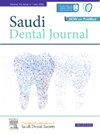Establishing the VR-haptic thinkers group: Insights and progress in dental training technologies
IF 2.3
Q3 DENTISTRY, ORAL SURGERY & MEDICINE
引用次数: 0
Abstract
In today’s fast-paced, digitalized world, dental educators and professionals alike need to try and stay up to date on current learning methods to provide the best possible education to the new generations of students. VR-haptic training allows educators to guide students in performing dental exercises within a digital environment using input methods with tactile force feedback features. This can reduce the mental burden of students due to fear of failure, as material losses are no longer a factor. Additionally, students can practice in their own time and pace, outside of teaching hours. Despite being digital, this mode of teaching has been shown to enable skill transfer to the real world, affording educators more flexibility with how to teach their students both before and during traditional methods of practical dental education. To help support the embracement of this new technology, a global VR-Haptic Thinkers Consortium was established in early 2024 and is now formed of 36 partner universities, institutions, and industrial companies. The second VR-Haptic Thinkers Meetup, held in mid-2024, was given the theme of “VR-Haptic Dentistry, Pedagogy, and Curriculum Evolution”. The theme of the meetup was timely as in recent years dental educators have all faced many challenges in education and research and have had to deal with rapid changes in supportive VR-haptic education. A robust program was featured to engage with the dental community members who are curious about the new technological advancements in dental education.
建立vr触觉思考者群体:牙科培训技术的见解和进展
在当今快节奏的数字化世界中,牙科教育工作者和专业人士都需要努力跟上当前的学习方法,为新一代学生提供最好的教育。vr触觉训练允许教育工作者指导学生在数字环境中使用具有触觉力反馈功能的输入法进行牙科练习。这可以减轻学生因害怕失败而产生的心理负担,因为物质损失不再是一个因素。此外,学生可以在教学时间之外按照自己的时间和节奏练习。尽管是数字化的,但这种教学模式已被证明能够将技能转移到现实世界中,为教育者提供了更大的灵活性,可以在传统的牙科实践教育方法之前和期间教授学生。为了支持这项新技术的普及,全球VR-Haptic思考者联盟于2024年初成立,目前由36所合作大学、机构和工业公司组成。第二届VR-Haptic思考者聚会于2024年年中举行,主题为“VR-Haptic牙科,教学法和课程演变”。由于近年来牙科教育工作者在教育和研究方面都面临着许多挑战,并且不得不应对支持vr触觉教育的快速变化,因此会议的主题非常及时。一个强大的程序是与谁是好奇在牙科教育的新技术进步牙科社区成员参与。
本文章由计算机程序翻译,如有差异,请以英文原文为准。
求助全文
约1分钟内获得全文
求助全文
来源期刊

Saudi Dental Journal
DENTISTRY, ORAL SURGERY & MEDICINE-
CiteScore
3.60
自引率
0.00%
发文量
86
审稿时长
22 weeks
期刊介绍:
Saudi Dental Journal is an English language, peer-reviewed scholarly publication in the area of dentistry. Saudi Dental Journal publishes original research and reviews on, but not limited to: • dental disease • clinical trials • dental equipment • new and experimental techniques • epidemiology and oral health • restorative dentistry • periodontology • endodontology • prosthodontics • paediatric dentistry • orthodontics and dental education Saudi Dental Journal is the official publication of the Saudi Dental Society and is published by King Saud University in collaboration with Elsevier and is edited by an international group of eminent researchers.
 求助内容:
求助内容: 应助结果提醒方式:
应助结果提醒方式:


